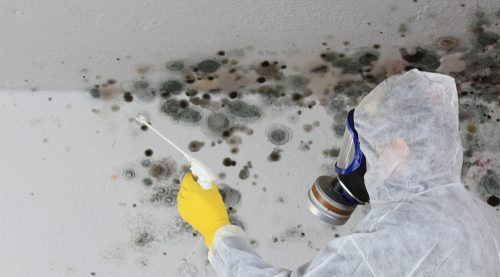
For decades in Baltimore City, landlords and tenants have been aware of lead paint regulations and laws. However, there is another growing problem invading homes throughout the city, mold. If you own or manage rental homes in the Baltimore City area, mold growth can quickly become costly. Mold issues leave you with not only expensive repair bills but the potential for tenant lawsuits that claim the mold made them ill. Below we will take an in-depth look at landlord liability for mold and how best to prevent it from happening to you.
What is Mold, and Is It Dangerous?
Mold is a type of fungus or microscopic organism that exists all around us. It is an essential part of the ecosystem, breaking down organic matter, and recycling nutrients. There are thousands of types of mold, but a select few are quite dangerous. Mold spores can enter your rental property in many ways, including open doors, windows, and HVAC system. Mold growth is commonly found in areas with flood damage, water leakage, or humid conditions. Microscopic spores usually do not cause any issues unless they adhere to a damp spot viable to their compounding growth. Check out the list below of toxic mold categories to look out for.
Types of Dangerous Mold in Your Rental Home
- Black Mold (Stachybotrys): Black mold is one of the most widely known and most dangerous types. Exposure can cause such symptoms as body aches, diarrhea, headaches, and memory loss. Additionally, prolonged exposure can even cause severe respiratory damage. While it isn’t healthy for anyone, children and those with compromised breathing are most at risk. Black mold thrives in damp areas and has a strong, musty odor.
- Chaetomium: Chaetomium also thrives in water-damaged homes. Clusters of growth are commonly seen in wet, dark environments such as drywall, wallpaper, baseboards, and carpeting. Additionally, Chaetomium often shares space with black mold, and it too can cause allergic reactions in some people. Besides allergy symptoms, it is essential to note that it can also result in neurological damage and certain autoimmune diseases.
- Aspergillus: These types of spores are common in the everyday air all of us breathe. That said, Aspergillus is especially harmful to individuals with compromised immune health. Exposure to this type of mold is known to cause allergic reactions, lung infections, and a specific type of infection known as aspergillosis.
Look Out for These Dangerous Molds As Well
- Penicillium: This type of mold is also quite common as you move through your daily lives. However, when confined to the air in your home, it can trigger asthmatic symptoms, bronchitis, and other respiratory problems.
- Fusarium: Fusarium is routinely found in organic debris and soil. That said, it can also thrive in damp areas of your home, such as under carpet, drywall or insulation, and HVAC systems. Although some severe side effects of exposure are rare, you should still steer clear of these spores.
Familiar Places to Find Mold Inside Your Rental Property
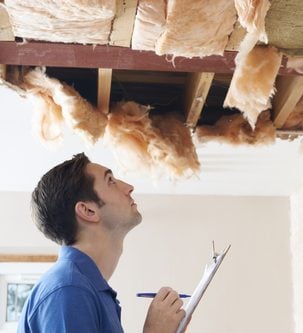
Here are just some of the many places throughout your Baltimore City investment property where mold growth can be found:
- Wood
- Paper (including cardboard and drywall)
- Carpet and Carpet Padding
- Food
- Large Gatherings of Dust
- Leaking Roofs and Ceilings
- Leaking or Damaged Plumbing
- HVAC System
- Insulation
- Fabric Or Other Porous Surfaces
What Does the Law Say About Landlord Liability for Mold?
Currently, there are no federal laws that outline’s landlord responsibility regarding mold disclosure. Additionally, Maryland doesn’t have any laws that specifically address a landlord’s duty for mold prevention and remediation. That does not mean you, as a landlord, are off the hook. Rent escrow and tenant vs. landlord suits have been on the rise for years. Landlords are by law required to provide safe and habitable housing; a severe mold problem can interfere with the habitability of the home. Mold-related lawsuits are becoming more prevalent. Tenants can allege health-related damages based on the landlord failing to address mold growth. While the law may not be crystal clear yet, do not find yourself in a situation like the ones below.
- October 2006 – $270,000 Judgement: Maryland lawsuit filed against the landlord by tenants claiming they were injured by unremedied mold in their rental home.
- March 2013 – $19,400 Judgement: A Montgomery County, MD tenant, notified her landlord of mold presence shortly after move-in. After the landlord refused to make repairs causing the tenant to break the lease for health reasons, the tenant sued. A jury found the tenant liable.
- January 2016 – $4.3 Million Dollar Lawsuit: Tenants sought millions in damages when a landlord failed to inspect or remedy a severe mold problem. The tenants complained, their health drastically declined, and the landlord tried to coerce them from seeking legal advice.
What Are The Health Effects of Toxic Mold Exposure
The concentration of mold spores inside of your rental home has the potential to trigger severe and possibly irreversible health problems for your tenants. Scientific research continues on the short and long term health effects of mold exposure, but there are many symptoms we do recognize.
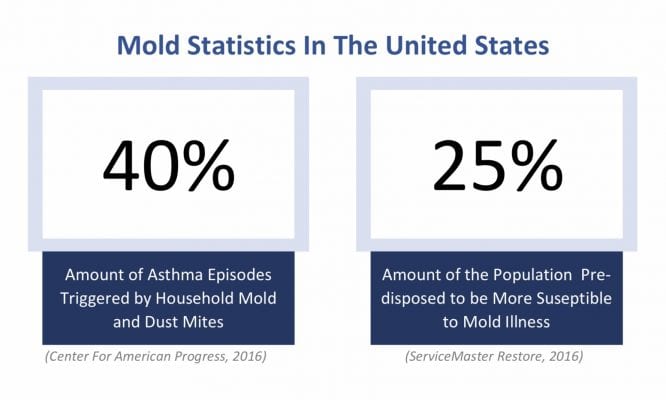
Symptoms of Mold Exposure
- Sneezing
- Runny nose
- Red eyes
- Skin rashes
- Throat and Lung Irritation
- Asthma Attacks
- Dry Cough
- Blocked Nose
- Sinusitis
- Wheezing
Preventing Mold Growth and Early Detection
Mold multiplies very quickly! The National Association of Home Builders claims that damp conditions can fuel mold growth in as little as 48 hours. So, it is vital to respond quickly at the first signs. Whenever possible, prevention is the best way to protect yourself from a potential battle with tenants. Experts agree there is a critical step a responsible landlord can take to prevent the mold growth: moisture control!
Tips for Early Detection of Mold
- Monitor high-risk areas such as basements, crawlspace, bathrooms, or around AC units regularly
- Test a suspected area by dabbing a few drops of bleach onto the discoloration. If, after 1 to 2 minutes, the area begins to lighten, you have mildew. If there is no change in appearance, it’s likely dirt.
- Follow your nose. Mold has a musty odor, be aware of any new smells around your home, particularly after heavy rains, flooding, or apparent water damage.
How to Prevent Mold Growth
- Identify at-risk areas
- Maintain indoor humidity levels below 50 percent, especially in basements
- Promptly address all leaks
- Increase air movement and ventilation where possible
- Run exhaust fans in the bathroom to reduce moisture build-up
- Keep refrigerator and dehumidifier drip trays emptied and clean
- Thoroughly clean typical hotspots where mold is likely to grow regularly
Landlord Liability for Mold When You See Signs of Growth
Mold remediation is a costly repair. The discovery of mold in your rental property can quickly become financially draining to a landlord. Landlord liability for mold requires you to provide tenants a safe and habitable home. Therefore, it is vital to your success to identify and treat problems as soon as you are aware of them. This will limit the spread, and in turn, cost needed to correct the problem. As a Baltimore City landlord, you need to have protocols in place on how to handle a report of mold at a property. Regardless of how minor you may think it sounds, mold claims should be taken seriously. Take a look at these suggestions below on what you can do when a report comes in.
-
Ask Plenty of Questions
Determine as much information as you can; this will allow you to assess the situation better. Find out why the tenant believes they have mold and request photos, if possible. Ask if there are any stains or discoloration and pinpoint the location of the issue.
-
Find the Source
Mold is caused by moisture in the home, and determining the source is crucial. It could be a plumbing leak, roof issue, clogged gutters, or HVAC condensation. Regardless, answering this question fast is key to getting a professional to fix it. The longer the issue sits undetected, the more damage will occur, and ultimately the more money repairs will cost. Once you know the location, the next step is to determine if any actual mold is present.
-
Hire Experts
If tests come back normal, that means you are dealing with a predominately cosmetic issue. In that regard, you will still want to remove any damp building materials and replace them. This will prevent mold from developing in the future. If the test is positive, you must immediately call in a mold remediation company. This can be extremely expensive, so seek out a couple of estimates.
Quick Tips to Find A Qualified Mold Inspector
It’s important to note that the mold remediation industry is mostly unregulated. Consequently, it can be challenging to know if you are dealing with a real expert. Follow these guidelines below.
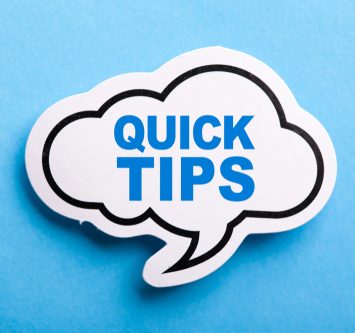
- Qualified inspectors should have a minimum of an undergraduate degree in science or engineering. Additionally, they should also have completed industry-approved courses in mold investigation, ideally from the American Board of Industrial Hygiene or the American Council for Accredited Certification.
- Respected industry credentials are crucial. Look for distinctions such as CIH (Certified Industrial Hygienist) or CIEC (Council-certified Indoor Environmental Consultant).
- Qualified inspectors should work independently of a mold remediation company. Furthermore, they shouldn’t sell mold-related products.
- A great inspector will provide you a customized report, including lab results of air or surface samples taken.
Steps for Mold Remediation and Average Cost
As you will discover, there are some tried and true methods for the disposal of mold in your home. The best solution is to hire an expert. Even the smallest amount left behind can restart growth and create further damage. Below is the typical process a restoration company will follow to eradicate spores in your rental property.
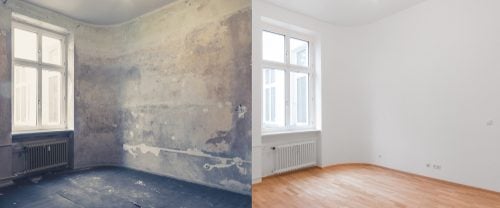
- Remove mold-infested materials and water damage.
- Clean and thoroughly disinfect all surfaces, including walls, carpet, and personal items.
- Remove infected drywall and studs if the damage is extensive.
- Vacuuming the area with HEPA (high-efficiency particulate air) filtration.
Luke Armstrong, Author at RestorationMaster, cites that mold growth destroys more wood per year than fire and termites combined. Consequently, the amount of money spent on mold remediation across the US each year tops millions of dollars. You can expect average costs for your household will vary based on the size and scope of the project. That said, below gives you an idea of typical costs associated with landlord liability for mold removal.

Mold not only creates a health risk but a massive liability for landlords. Therefore, understanding landlord liability for mold is an essential component of financial wellbeing. The tips above will help you to recognize the signs, prevent issues from arising, and steps to take if they do. Looking for a property manager in Baltimore? Contact Bay Property Management Group to learn about our comprehensive property management services.
